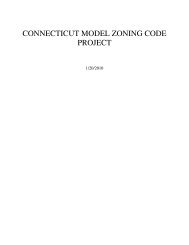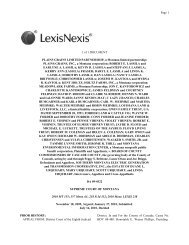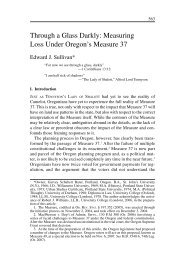LEXSEE DANIEL GUGGENHEIM; SUSAN ... - Land Use Law
LEXSEE DANIEL GUGGENHEIM; SUSAN ... - Land Use Law
LEXSEE DANIEL GUGGENHEIM; SUSAN ... - Land Use Law
You also want an ePaper? Increase the reach of your titles
YUMPU automatically turns print PDFs into web optimized ePapers that Google loves.
2010 U.S. App. LEXIS 25981, *45Page 14concurrence, Justice Scalia was even more explicit incriticizing the methodology employed by the majorityhere:In my view, the fact that a restrictionexisted at the time the purchaser took title. . . should have no bearing upon thedetermination of whether the restriction isso substantial as to constitute a taking. The'investment-backed expectations' [*46]that the law will take into account do notinclude the assumed validity of arestriction that in fact deprives property ofso much of its value as to beunconstitutional.Id. at 637 (Scalia, J., concurring) (emphasis added)(internal citation omitted). The majority's dismissal of theGuggenheim's investment-backed expectations, on thebasis that they knew what they were getting into, directlycontravenes Supreme Court precedent and assumes theeternal validity, without reform, of the so-called rentcontrol ordinance. 7 It does not come as a surprise themajority's stance on this subject comes without legalauthority.7 Not only does Palazzolo recognize theGuggenheims' ability to bring a takings claim onthe basis of their own reasonableinvestment-backed expectations, but it alsoacknowledges the ability of a land owner to bringa regulatory takings action for a loss in value thatwas suffered by a previous land owner. AsPalazzolo points out, the government is notabsolved of its obligation to defend actionsrestricting land use, merely on account of apostenactment transfer of title. 533 U.S. at 627. Arule barring land owners from challengingordinances that were enacted during a [*47]previous landowner's tenure, the Court explained,"would work a critical alteration to the nature ofproperty, as the newly regulated landowner isstripped of the ability to transfer the interestwhich was possessed prior to the regulation. TheState may not by this means secure a windfall foritself." Id. Consequently, the panel majority'sobservation that any unfairness attributable to therent control ordinance "was imposed long ago []on someone earlier in the Guggenheims' chain oftitle," is unavailing. Maj. Op. at 20437. Palazzolomakes clear that to the extent a previouslandowner had the right to bring a regulatorytakings challenge against an ordinance enactedduring its tenure, successive landowners enjoy thesame right. 533 U.S. at 627. Thus, even thoughthe ordinance at issue effected a wealth transferfrom the previous land owner to tenants in 1979and 1987, which wealth transfer is kept in placeby the 2002 Goleta ordinance, the Guggenheimsmay challenge the ordinance and seek recovery onthe basis of the previous land owner's loss. Id.That loss is passed on to the Guggenheims as anincident of property ownership. In accountingterms, it is a transferable contingent [*48] asset.The majority opinion asserts that Palazzolo "is of nohelp to the Guggenheims," Maj. Op. at 20431, but one ispuzzled by its attempts to distinguish Palazzolo. Themajority notes that the claimant in Palazzolo challengedthe land-use regulation as it was applied to him, whereashere, the Guggenheims bring a facial challenge to theOrdinance. Id. at 20431. So? Penn Central involved anas-applied challenge; but it gave us rules of generalapplication as to what constitutes a regulatory taking. 8Next, the majority points out the transfer in Palazzolowas by operation of law (the claimant, as controllingshareholder of the corporation which owned the land,acquired the property when the corporation dissolved),whereas the Guggenheims purchased the mobile homepark on the open market. So? The plaintiff in Palazzoloacquired title after the challenged land-use restriction wasenacted and nonetheless prevailed without claiming thathe should be considered to have become the owner whenhis corporation bought the land before the restriction'senactment, on some theory of advantageous piercing ofthe corporate veil cum relation back. These "distinctions"are mere differences, no more [*49] significant than thatthe Palazzolo land was in Rhode Island 9 and theGuggenheim land was in California.8 See Lingle, 544 U.S. at 539 (calling the PennCentral factors the "principal guidelines forresolving regulatory takings claims"); see alsoChevron USA, Inc. v. Cayetano, 224 F.3d 1030,1032-33 (9th Cir. 2000) (describing the facialchallenge addressed in Lingle).9 Where he was up against a more formidableand resourceful takings opponent: the State ofRhode Island and Providence Plantations. Here,the Guggenheims face the town of Goleta.







